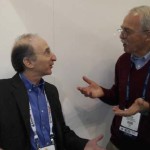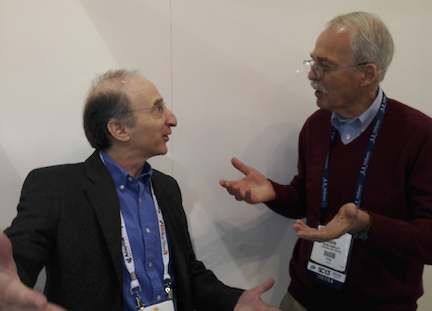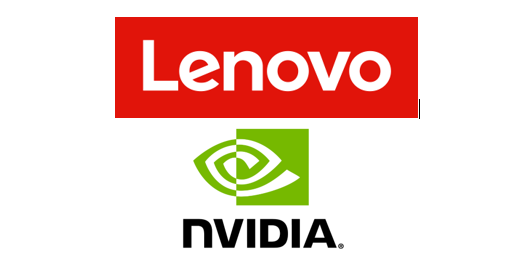
Dr. Saul Perlmutter (left) holds an animated conservation with John Kirkley at SC13. Photo by Sharan Kalwani, Fermilab
In this special feature, John Kirkley sits down with Dr. Saul Perlmutter. A Nobel prize winning astrophysicist, Dr. Perlmutter’s talk at SC13 focused on how integrating big data — and careful analysis — led to the discovery of the acceleration of the universe’s expansion.
In 1997, based on his study of the exploding stars known as supernovae Type 1a, astrophysicist Saul Perlmutter expected to find a universe whose expansion, kicked off by the Big Bang some 13.7 billion years ago, was slowing. He found just the opposite.
Incredulous, he and his team checked and rechecked the data and finally published their results. Those results earned Dr. Perlmutter the Nobel Prize for physics in 2011.
He is an astrophysicist at the Lawrence Berkeley National Laboratory and a professor of physics at the University of California, Berkeley. He heads the Supernova Cosmology Project at the Lab.
John Kirkley: Saul, tell me about the work that led up to the Nobel Prize.
Saul Perlmutter: In the early part of the (Supernova Cosmology) project we knew we had a really great opportunity to measure something absolutely profound – the state of the universe and whether the universe was going to last forever. Also, if we lived in a universe that was infinite or finite.
Ever since Einstein’s theory of general relativity gave us a basic feel for the universe, we’ve been wondering: is it slowing down enough to come to a halt and collapse? (if there is enough stuff in the universe, gravity will do that.) Or will it expand forever? Also, is there enough stuff in the universe, enough gravity, to curve space in on itself so that there’s only a finite amount of real estate out there. These were the big questions we had on our minds at the time.
We had an opportunity to make the measurements using these exploding stars, these supernovas that we started discovering in the mid-eighties – specifically one kind of supernova, called Type 1A, that makes a great “standard candle.” You can identify it by its structure and once you’ve recognized it, you know it will always be roughly the same brightness – it reaches it peak in a couple of weeks and fades away over a couple of months. So it tells you how far you’re seeing across the universe. These are vast distances – light has been traveling toward us for five billion, ten billion years from these exploding stars and we use that to tell us how much the universe has stretched since those early times.
The project took much longer than we had originally estimated. We thought it would be a three year project, but by the end of three years we hadn’t yet found our first supernova. After five years we had developed the technique that would help us find the supernovas; after nine years we used those techniques to find 42 standard candles. We were ready to plot the information. When we created the plot, we were in for a surprise. We realized that the universe was not slowing down enough to come to a halt, it was actually speeding up. And ever since then we’ve been trying to figure out why, to understand what can be causing the universe to accelerate in an expansion that is getting faster and faster.
The two main options we’re now considering are the effects of a new energy that pervades all of space – what we call “dark energy;” or it could be that we have to change Einstein’s theory of general relativity.
John Kirkley: But Einstein’s theory is pretty sacrosanct, isn’t it?
Saul Perlmutter: Yes, it would be pretty amazing if that were true. Einstein’s theory works well to many digits of precision – it seems to be a very robust theory so changing it would be very difficult. And nobody knows what this change might be.
John Kirkley: During the period when you first started this work and now, have you developed some automated systems to find the Type 1a supernovas?
Saul Perlmutter: Yes, over the years we have advanced our capabilities to find these standard candles and have developed techniques that are running on large telescopes around the world every night. Originally we could only get a few nights per semester; but now it’s become a real effort for many groups. Where once we had 42 supernovas we now have over 700 that people use for this purpose.
Even so we need a whole new level of precision, so we are developing techniques to calibrate the supernovas to a much higher degree of accuracy than was ever done before. We are now building the next generation of instruments that will allow us to actually collect that data to very high resolutions. We need more supercomputers to narrow down the history of expansion because there are subtle differences in the histories that you get when using the theory of dark energy or Einstein’s theory of general relativity.
John Kirkley: Obviously high performance computing plays a huge role.
Saul Perlmutter: This is all data intensive. From the very moment that you’re trying to find the supernova, you’re hunting for a little, tiny spark of light embedded in collections of thousands of images where each image is many megapixels, or even gigapixels collected by the big mosaic cameras. And then, to analyze the data and compare your results to different cosmological models also requires large computers, as do the Monte Carlo and all the statistical models you need. Finally to compare these many models derived from first principles, require simulations of exploding stars – so that’s another large computer job that is part of the story.
John Kirkley: Big Data with a vengeance.
Saul Perlmutter: Absolutely. And that’s just one technique. Now other techniques are being built. For example, baryon acoustic oscillators (BAO). So we will be able to compare results using different techniques, which is crucial.
John Kirkley: Will the work that you’re doing actually shed light on the nature of dark matter and dark energy?
Saul Perlmutter: We hope that by doing a very precise measurement of the history of expansion, it will tell us about the properties of dark energy, which dominate theories of expansion today. Dark matter is in play in other ways – e.g., the clumping of matter in the universe. If we are able to study how matter clumps, this will help us understand the behavior of gravity and helps us distinguish Einstein’s theory of relativity from the dark energy explanations of expansion.
John Kirkley: And maybe come up with a “theory of everything?”
Saul Perlmutter: Exactly. That’s the big goal. We’ll eventually get a handle on both mysteries – dark energy and dark matter.
John Kirkley: What do you see coming up in the near future?
Saul Perlmutter: There are a number of ambitious projects in development which, in the next ten years, will allow us to conduct a more precise measurement of the universe than we’ve ever seen before. These projects use ground based telescopes and robotic controllers so you can position thousands of optical fibers exactly where the light from a galaxy will fall into the telescope. This allows us to study millions of galaxies in just a year of observation.
Another advance is that we’re developing new space missions like the Wide-Field Infrared Survey Telescope (WFIRST), which comes out of an earlier project we developed call SNAP (Supernovae Acceleration Probe). These are cameras with a field of view that is hundreds of times bigger than previous equipment. You can get a much more comprehensive survey of the universe than you ever could with Hubble-based telescopes, allowing us to find fascinating and unusual targets. For this kind of work, the surveys are the entire story. If you can understand the behavior of big chunks of the sky all at one time, we think that we’ll get a real handle on dark energy and dark matter.
We’re hoping that WFIRST will move ahead about the same time as the James Webb Space Telescope (JWST), because traditionally you always want a wide field telescope to find targets while at the same time you have the capabilities of a deep focusing telescope like the JWST.
John Kirkley: Over the centuries physics and astronomy have repeatedly changed the way we view the universe and our place in it – from Ptolemy to Copernicus and Galileo to Newton, Einstein and quantum physics. Do you see this happening again?
Saul Perlmutter: Absolutely. I think it’s a very interesting period for human cosmology because it’s a golden age in which every ten years we learn breathtaking new parts of the story. We have never before been able to do that in human history – to have the chance we have now to look at and understand the universe we live in. We will find bigger and bigger surprises as we move along. Already we’re discovering that the universe is not a simple, static place; we now know that it’s expanding and this expansion is accelerating. We also know that behavior of the universe is changing – its gone through periods of rapid acceleration, then slowed, then speeded up. We also know now that some of the basics of how the universe works have changed. Which is remarkable. We have assumed that we lived with a simple set of laws, but apparently some very big attributes of the universe are contingent. This is our opportunity to think about the universe in which we live in ways that are very different from how we think about it now.
John Kirkley: So perhaps even the laws of physics themselves are changing?
Saul Perlmutter: It’s very possible that some of what we take as absolute – the givens of physics – may turn out to be evolving as well.





Enjoyed the article and the talk by Saul. I do sincerely believe that we have an untold amount of undiscovered & wondrous discoveries that lie before us and our understanding of nature will take a huge shift. It was privilege to hear his thoughts and views – I do wish to send a message to future SC 20xy organizers to arrange a few more such laureates to come, share their perspectives with supercomputing conference attendees.